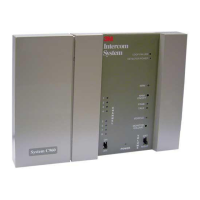6
Connecting the Base Station to Components Using the Optional Interconnect Module
Connect the base station to the interconnect module as shown in Figure 6. Note that the connections are made to
the “TO CONTROL MODULE” terminals on the interconnect module.
Figure 6. Base Station – Interconnect Module Connections
Connect the components (vehicle detector, speaker/microphone, and optional monitor speaker) to the interconnect
module as shown in Figure 7. Note that the connections are made to the “TO OUTSIDE” terminals on the
interconnect module.
*Note
If an optional back–up (auxiliary) intercom is connected to the “TO AUXILIARY INTERCOM”
on the interconnect module, the base station must be turned off to enable operation/usage of the
back–up intercom.
Use 18–20 gauge twisted–pair audio wire for all connections except the microphone. Use an 18–20 gauge
shielded twisted–pair audio wire for the connection to the microphone.

